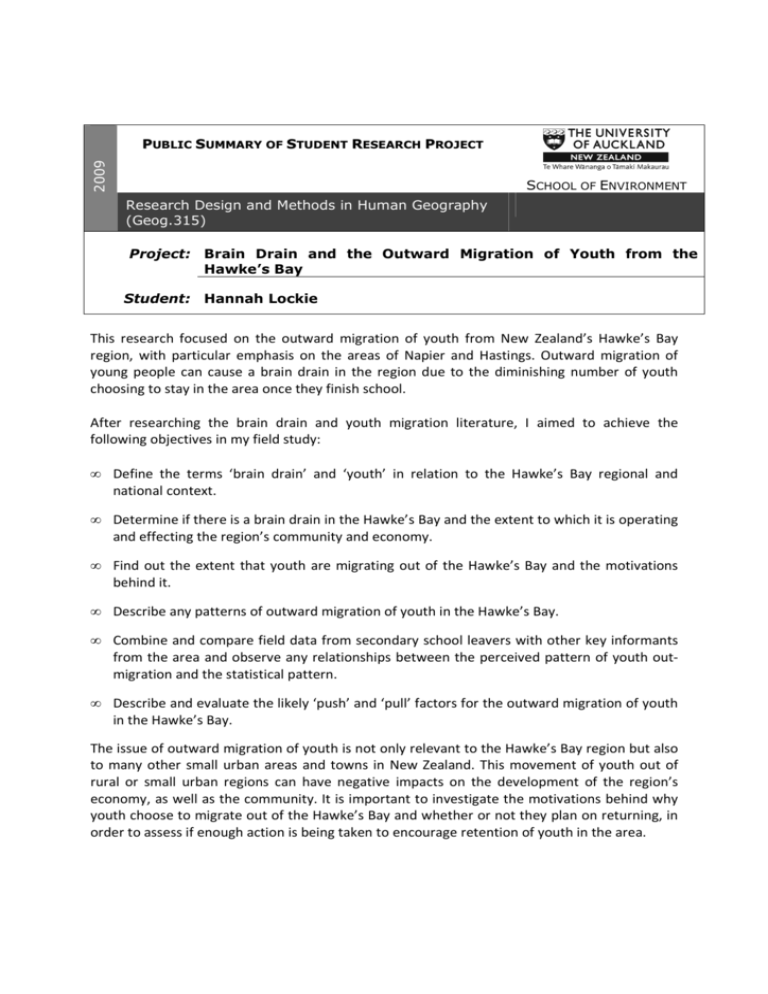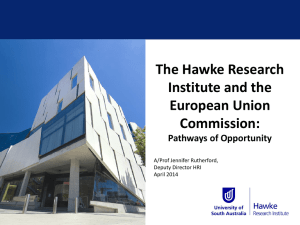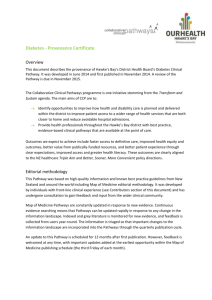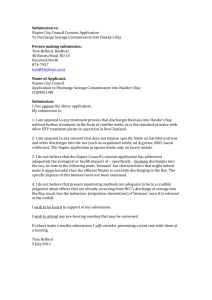Brain Drain and the Outward Migration of Youth from the Hawke's Bay
advertisement

2009 PUBLIC SUMMARY OF STUDENT RESEARCH PROJECT SCHOOL OF ENVIRONMENT Research Design and Methods in Human Geography (Geog.315) Project: Brain Drain and the Outward Migration of Youth from the Hawke’s Bay Student: Hannah Lockie This research focused on the outward migration of youth from New Zealand’s Hawke’s Bay region, with particular emphasis on the areas of Napier and Hastings. Outward migration of young people can cause a brain drain in the region due to the diminishing number of youth choosing to stay in the area once they finish school. After researching the brain drain and youth migration literature, I aimed to achieve the following objectives in my field study: • Define the terms ‘brain drain’ and ‘youth’ in relation to the Hawke’s Bay regional and national context. • Determine if there is a brain drain in the Hawke’s Bay and the extent to which it is operating and effecting the region’s community and economy. • Find out the extent that youth are migrating out of the Hawke’s Bay and the motivations behind it. • Describe any patterns of outward migration of youth in the Hawke’s Bay. • Combine and compare field data from secondary school leavers with other key informants from the area and observe any relationships between the perceived pattern of youth outmigration and the statistical pattern. • Describe and evaluate the likely ‘push’ and ‘pull’ factors for the outward migration of youth in the Hawke’s Bay. The issue of outward migration of youth is not only relevant to the Hawke’s Bay region but also to many other small urban areas and towns in New Zealand. This movement of youth out of rural or small urban regions can have negative impacts on the development of the region’s economy, as well as the community. It is important to investigate the motivations behind why youth choose to migrate out of the Hawke’s Bay and whether or not they plan on returning, in order to assess if enough action is being taken to encourage retention of youth in the area. Survey questionnaires were used in order to obtain quantitative comparable data from secondary school students of school leaving age. The aim of the questionnaire was to determine the patterns of youth movement, the motivations and restraints of migrating, and obtain information directly from the research focus group. The questionnaires were anonymous, with 22 structured questions covering the student’s gender and ethnicity, parent’s income and occupation, after school plans, influencing factors behind their plans, factors encouraging and restraining migration, and their views on tertiary education. Interviews were also conducted to attain the opinions of those who know the area well and can therefore provide valid information regarding the migration of youth. The interviews were semistructured with an informal interviewing style to allow the conversation to access observations specific to the interviewee. From these interviews I obtained unique qualitative information as each person I interviewed had a different background, education, occupation and perspective on the issue of outward youth migration. A large majority of youth move out of the Hawke’s Bay once they leave school. Out of those who do migrate away, most of them go for tertiary level study, either in Wellington or Palmerston North. What is interesting is that some of the students still planned on leaving the Hawke’s Bay even though they had no plans of what they were going to do. This suggests that there is a cultural or community dimension to this migration pattern where it is considered a ‘natural’, ‘healthy’, and a pseudo rite-of-passage for youth to migrate out of the region to mature, grow and experience the world. There was also some evidence suggesting that there could be a return flow of people in their thirties and older back to the Hawke’s Bay. It is possible this has resulted from a desire to return to their home town and raise a family in a smaller community. A predominant limitation was the participation of only two secondary schools in the questionnaires. Although more schools would have been beneficial, this limitation was uncontrollable as participation was completely voluntary. Secondary school’s Tournament Week could have been a contributing factor to this, meaning that quite a few students were absent from class because they were representing their school in a sports tournament. The students who remained were going through mock examinations preparations. Unwillingness to disrupt students during this time of year may have contributed towards schools declining participation in the research. The second limitation is that the two classes I visited were both geography classes. This could have influenced the data collected because students who excel in other disciplines, like mathematics, languages, or performing arts could be excluded from the data and have differing after school plans. Key words Brain drain, youth, outward migration, university, opportunities







